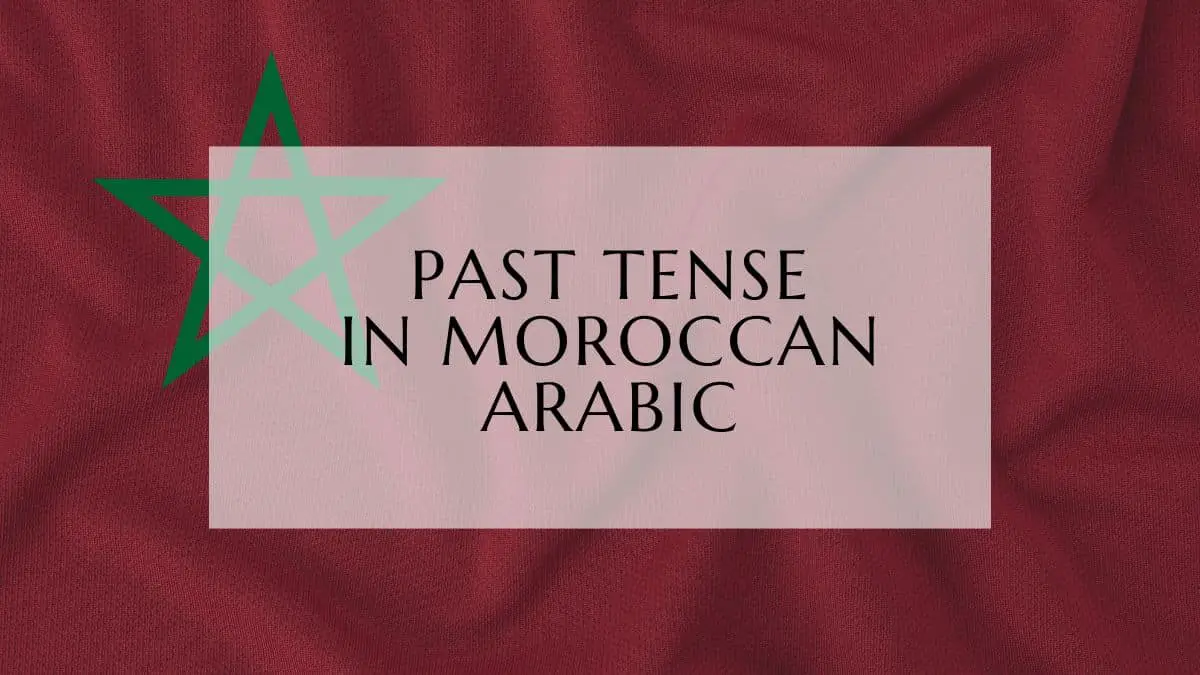In this lesson, we will discuss the past tense in Moroccan Arabic, the suffixes added to every type of the 4 Darija verb types, followed by examples. (We talked about the 4 types in this post here. Let’s get started!

Past Tense In Moroccan Arabic
The Past Tense Form In Moroccan Arabic
We will use the form below for every verb type with a few tweaks:
| English | Transcribed Moroccan Arabic | Using Arabic Alphabet |
| I (masculine) | Ana …t | أنا …ت |
| You (feminine, singular) | Nti / Ntiya …ti | نتي / نتيا …تي |
| You (masculine, singular) | Nta / Ntaya …ti | نتا / نتايا …تي |
| He | Howa …- | هو …- |
| She | Hia …at | هي …ات |
| We | 7na …na | حنا …نا |
| You (plural) | Ntuma …tu | نتوما …تو |
| They | Huma …o | هوما …و |
Note: you can practice what you’ve learned here, and learn how to pronounce each of the words in our Memrise course here, don’t know how to use the platform or sign up? we’ve got you covered in this easy-to-follow tutorial here.
Past Tense Form For CCC
To conjugate CCC verbs like ktb, lbs, gls, we just add the prefix:
Conjugation of ktb (to write) in the past:
| English | Transcribed Moroccan Arabic | Using Arabic Alphabet |
| I (masculine) | Ana ktbt | أنا كتبت |
| You (feminine, singular) | Nti / Ntiya ktbti | نتي / نتيا كتبتي |
| You (masculine, singular) | Nta / Ntaya ktbti | نتا / نتايا كتبتي |
| He | Howa ktb | هو كتب |
| She | Hia ktbat | هي كتبات |
| We | 7na ktbna | حنا كتبنا |
| You (plural) | Ntuma ktbtu | نتوما كتبتو |
| They | Huma ktbo | هوما كتبو |
Past Tense Form For CC Verbs
To conjugate CC verbs like sed, keb we add an “i” before the past tense suffix in the first and second pronouns (both singular and plural) :
Conjugation of keb (to pour) in the past:
| English | Transcribed Moroccan Arabic | Using Arabic Alphabet |
| I (masculine) | Ana kebit | أنا كبيت |
| You (feminine, singular) | Nti / Ntiya kebiti | نتي / نتيا كبيتي |
| You (masculine, singular) | Nta / Ntaya kebiti | نتا / نتايا كبيتي |
| He | Howa keb | هو كب |
| She | Hia kebat | هي كبات |
| We | 7na kebina | حنا كبينا |
| You (plural) | Ntuma kebitu | نتوما كبيتو |
| They | Huma kebo | هوما كبو |
Past Tense Form For CCV Verbs
To conjugate CCV verbs like shra, kla we replace “a” with “i” before the past tense suffix in the first and second pronouns (both singular and plural) :
Conjugation of shra (to buy) in the past:
| English | Transcribed Moroccan Arabic | Using Arabic Alphabet |
| I (masculine) | Ana shrit | أنا شريت |
| You (feminine, singular) | Nti / Ntiya shriti | نتي / نتيا شريتي |
| You (masculine, singular) | Nta / Ntaya shriti | نتا / نتايا شريتي |
| He | Howa shra | هو شرا |
| She | Hia shrat | هي شرات |
| We | 7na shrina | حنا شرينا |
| You (plural) | Ntuma shritu | نتوما شريتو |
| They | Huma shraw (o becomes w after a) | هوما شرو |
Conjugation of ja (to come) in the past:
| English | Transcribed Moroccan Arabic | Using Arabic Alphabet |
| I (masculine) | Ana jit | أنا جيت |
| You (feminine, singular) | Nti / Ntiya jiti | نتي / نتيا جيتي |
| You (masculine, singular) | Nta / Ntaya jiti | نتا / نتايا جيتي |
| He | Howa ja | هو جا |
| She | Hia jat | هي جات |
| We | 7na jina | حنا جينا |
| You (plural) | Ntuma jitu | نتوما جيتو |
| They | Huma jaw | هوما جو |
Past Tense Form For CVC Verbs
To conjugate CVC verbs like ban, tar, gal we remove “a” with (except for hiya, howa and huma) and then add the past tense suffix:
Conjugation of tar (to fly) in the past:
| English | Transcribed Moroccan Arabic | Using Arabic Alphabet |
| I (masculine) | Ana trt | أنا طرت |
| You (feminine, singular) | Nti / Ntiya trti | نتي / نتيا طرتي |
| You (masculine, singular) | Nta / Ntaya trti | نتا / نتايا طرتي |
| He | Howa tar | هو طار |
| She | Hia tarat | هي طارت |
| We | 7na trna | حنا طرنا |
| You (plural) | Ntuma trtu | نتوما طرتو |
| They | Huma taro | هوما طارو |
Conjugation of gal (to say) in the past:
| English | Transcribed Moroccan Arabic | Using Arabic Alphabet |
| I (masculine) | Ana glt | أنا قلت |
| You (feminine, singular) | Nti / Ntiya glti | نتي / نتيا قلتي |
| You (masculine, singular) | Nta / Ntaya glti | نتا / نتايا قلتي |
| He | Howa gal | هو قال |
| She | Hia galat | هي قالت |
| We | 7na glna | حنا قلنا |
| You (plural) | Ntuma gltu | نتوما قلتو |
| They | Huma galo | هوما قالو |
Happy learning!
